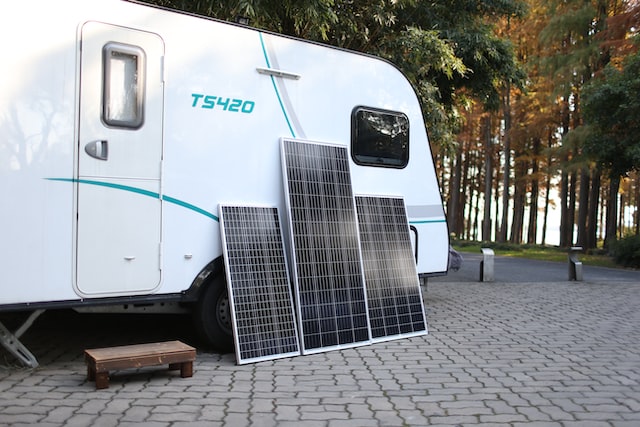Table of Contents
TogglePlug-in solar panels have been around since the early 2010s but only began gaining widespread attention sometime in the mid-2010s up till now.
Compared to traditional solar panels, their convenience and portability make them ideal for people who want to experiment with solar power or have limited space for solar panel installation.
This article aims to answer your common questions about plug-in solar panels, from understanding your needs to installing your solar panels and much more.
What is a plug-in solar panel?
Plug-in solar panels are small solar energy systems that you can plug into a regular electrical outlet at home. They have a few components, which are:
- Solar panels: Plug-in solar panels usually come in kits that include one or more solar panels, depending on your required power output. These panels are typically smaller and designed for residential use.
- Inverter: The kit also includes a solar inverter, which converts the solar panels’ direct current (DC) electricity into alternating current (AC) electricity, which is compatible with household appliances and the electrical grid.
- Plug connection: The system is designed to plug directly into a standard electrical outlet, simplifying installation. This eliminates the need for specialized wiring or mounting equipment.
- Grid connection: The solar panels generate electricity during daylight hours once plugged in. Any excess electricity generated beyond what the household consumes is typically fed back into the electrical grid, often resulting in credits or savings on electricity bills.
How do plug-in solar panels work?
Plug-in solar panels harness sunlight and convert it into usable electricity for your home. Solar panels are usually made of photovoltaic cells and semiconductor materials that absorb sunlight to generate an electric current.
When sunlight hits the photovoltaic cells, it excites the electrons within the cells, causing them to move and create an electric current. The solar panels produce direct current (DC), which the inverter will convert to alternating current (AC) to be compatible with your home’s electrical system.
The converted AC electricity can then be used to power your household appliances and electronics, reducing your reliance on electricity from the grid.
If your plug-in solar panel system is connected to the electrical grid, any excess electricity can be fed back into the grid through net metering, where you receive credits or compensation for the electricity you contribute to the grid.
What are some benefits of choosing plug-in solar panels?
Free electricity generation
Plug-in solar panels dramatically reduce or eliminate electricity bills, offering substantial long-term cost savings and a strong return on investment.
Portable power supply
Plug-in solar panels are often portable, allowing you to move them around your property or take them with you if you move house. This flexibility enables you to maximize solar exposure and adapt to changing energy needs or environmental conditions.


Less dependence on the grid
By generating your electricity, you reduce reliance on the grid, enhancing energy security and ensuring a consistent power supply even during high demand or disruptions.
What are the different uses for plug-in solar panels?
Plug-in solar panels offer versatile applications, with the most prevalent uses in residential settings, recreational vehicles (RVs), and campers.
Residential settings
Plug-in solar panels for homes are designed to provide residential properties with a renewable energy source. They can be installed in yards, balconies, or any outdoor area with ample sunlight. These panels generate electricity that can be used to power household appliances, lighting, electronics, and other electrical devices within the home.


Recreational vehicles (RVs)
Meanwhile, plug-in solar panels for RVs (recreational vehicles) are designed for mobile use. They are typically compact, lightweight, and portable, making them ideal for RV owners who want to harness solar energy while traveling or camping off-grid.
These panels can be easily installed on the roof or exterior of an RV and connected to the vehicle’s electrical system to provide power for onboard appliances, lighting, and other amenities.
Campers
Lastly, similar to plug-in solar panels for RVs, plug-in solar panels for campers are designed for portable use in camping environments. These panels are compact, easy to set up, and can be placed in sunny areas near campsites to capture sunlight.
They provide a renewable energy source for charging electronic devices, powering camping gear, and lighting campsites.


How do you set up plug-in solar panels?
Setting up plug-in solar panels is designed to be relatively simple and can typically be done without professional assistance. Here’s a general overview of the setup process:
- Choose a location: Select a location for your solar panels with plenty of good access to sunlight. This is usually outdoors in a sunny area, such as a yard or balcony, where the panels can receive direct sunlight for most of the day.
- Assemble the components: Unpack your plug-in solar panel kit and assemble the components according to the manufacturer’s instructions. This typically involves connecting the solar panels to the inverter and any other included components.
- Position the panels: Place the solar panels in the chosen location, ensuring that they are securely positioned and angled to receive maximum sunlight. Many plug-in solar panel kits come with mounting brackets or stands to help position the panels optimally.
- Connect to an outlet: Plug the solar panel system into a standard electrical outlet using the provided power cord. Ensure that the outlet is suitable for the system’s voltage and current requirements, and consider using an outdoor-rated extension cord if needed.
- Check for power: Once connected, check that the solar panels are generating power by observing any indicator lights on the inverter or monitoring the electricity output using a power meter or monitoring app if provided.
- Monitor performance: Keep an eye on the performance of your plug-in solar panel system over time. Monitor the electricity production and check for any signs of issues, such as shading or damage to the panels.
- Grid connection (Optional): If your plug-in solar panel system is designed to connect to the electrical grid, follow any additional instructions provided by the manufacturer to set up the grid connection. This may involve installing a grid-tie inverter or coordinating with your utility provider.
Safety precautions to keep in mind
Ensure your safety when dealing with plug-in solar panels by thoroughly reading and understanding the manufacturer’s instructions. Avoid overloading electrical outlets and ensure weatherproofing for outdoor installations.
Properly position panels to maximize sunlight exposure and follow local electrical codes for wiring. Ground the system correctly, conduct regular maintenance checks, and have an emergency plan. Keep children and pets away from the system, and use caution with electricity at all times to prevent accidents or injuries.
What factors can affect the efficiency of plug-in solar panels?
Several factors influence the efficiency of plug-in solar panels. Firstly, sunlight availability is crucial. Panels perform best in direct sunlight, so factors like geographic location, time of year, and shading from nearby objects can affect efficiency.
On top of that, panel angle and orientation impact efficiency. Adjusting panels to face the sun optimally throughout the day enhances performance. Panel cleanliness matters because accumulated dirt and debris reduce sunlight absorption. In this case, regular cleaning is essential.
Additionally, temperature affects efficiency; panels operate less effectively at high temperatures. Finally, the quality of components, including panels and inverters, influences overall efficiency.
Considering and optimizing these factors can enhance plug-in solar panel efficiency, maximizing renewable energy generation.
Read: How to increase solar panel efficiency?
What is the price to buy and install plug-in solar panels?
The price to buy and install plug-in solar panels can vary widely depending on several factors, including the size of the system, brand, quality of components, installation complexity, and any additional features or accessories included.
For plug-in solar panel kits designed for DIY installation, prices can range from a few hundred to several thousand dollars, depending on the size and specifications of the system.
If you hire a professional installer, installation costs typically add to the total expense. Installation costs vary based on labor rates, location, roof type, and any additional electrical work required.
As a rough estimate, the total cost to buy and install plug-in solar panels can range from a few thousand dollars for smaller systems to tens of thousands for larger or more complex installations.
It’s essential to obtain quotes from multiple suppliers and installers and carefully consider all costs involved before deciding.
Frequently Asked Questions (FAQs)
Are plug-in solars worth it?
Plug-in solar panels can be worth it depending on factors like energy usage, sunlight availability, upfront costs, and local regulations.
Are plug-in solar panels safe to use?
Yes, plug-in solar panels are generally safe to use when installed and operated according to manufacturer instructions, following safety precautions.
What do I plug my solar panel into?
Using the provided power cord, you can plug your solar panel into a standard electrical outlet.
Can I just plug a solar panel into an outlet?
Yes, plug-in solar panels are designed to be plugged directly into standard electrical outlets.
Are plug-in solar panels suitable for every home?
Plug-in solar panels may not be suitable for every home, depending on factors like sunlight exposure, energy needs, roof space, and local regulations.
What types of batteries are compatible with plug-in solar panels?
Plug-in solar panels are typically designed for grid-tied systems and do not require batteries, but if needed, compatible batteries include deep-cycle lead-acid or lithium-ion batteries.
What size plug-in solar panel do I need?
The size of the plug-in solar panel you need depends on factors like energy usage, available sunlight, and system efficiency.
What is the warranty period for plug-in solar panels?
Warranty periods for plug-in solar panels vary by manufacturer but typically range from 5 to 25 years.
Is plug-in solar legal?
Plug-in solar panels are generally legal to use in many areas, but it’s essential to check local building codes, zoning regulations, and utility policies before installation.
Conclusion
In conclusion, plug-in solar panels offer a convenient and accessible way for homeowners to harness solar energy, providing potential cost savings, energy independence, and environmental benefits.
While not suitable for every situation, their simplicity, affordability, and versatility make them an attractive option for those looking to embrace renewable energy and reduce their carbon footprint.





